Temporary
Studio: "Monthly Evaluations"
For contemporary artists, the studio is no longer the only place where
to think means to make. Concurrently, nor the gallery is the space of
passive consumption, where the public contemplate finished material
forms. The new culture of activity scrambles the dividing line between
practice and reflection, positioning the artist and the work in an infinite
chain of contributions, without a fixed identity. What is the current
space for art production and display, when the site-responsive practices
and the recycle of pre-existing ideas or materials produced somewhere
else (i.e. postproduction and post-studio situation) are rendering the
traditional studio and gallery redundant? How relationships to artist,
audience and to work which is more and more hybrid and immaterial develop?
Can the viewers transgress territorial lines and have a complete experience
of the complex nature of artistic process and its outcome?
The project Temporary Studio explores the spaces for art production and display today, both from the perspective of those practices which redefine the understanding of creative process and the relationship between art, work and audience, and from the point of view of the lack of appropriate studio and gallery spaces in Romania. The artists will be given temporary space for reflection and action, and the audience will be empowered to see exactly how art is made, through a process that aims at introducing a social dimension into an aesthetic realm.
Ioana Nemes is the first artist invited to experiment the possibility of ameliorating the function of a space according to the necessities of creative process, within a context tainted by the equality of indifference. Monthly Evaluations is not a site-specific project, but a context-sensitive one. The work develops as a nonlinear diary that archives diverse experiences assessed through written comments and associated visual representations, codified in a personal symbolic system. Ioana Nemes documents and evaluates daily the distance between her goals and achievements. The process becomes the project itself, and the intensity of her subsequent emotions viruses permanently the intuitive logic of the unconscious that keeps the limit between reality and the imaginary.
Simulacra and emergency procedures do not provide spectacular solutions. However, they can temper the loneliness and the savageness of the project. Temporarily.
Simona Nastac
curator
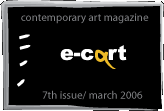 |
|
|
||||||||||||||||||
 |
 |
 |
|
|||||||||||||||||
| |
|
|||||||||||||||||||
 |
|
|
|
|||||||||||||||||
| |
|
|||||||||||||||||||
 |
|
|||||||||||||||||||
 |
 |
|
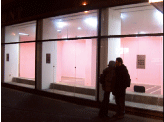 |
|
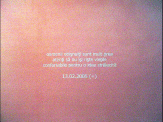 |
 |
|
|||||||||||||
| |
 |
|
|
|||||||||||||||||
| |
|
|
|
|||||||||||||||||
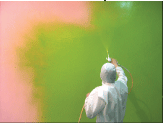 |
 |
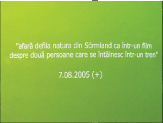 |
|
|||||||||||||||||
| |
|
|
|
|||||||||||||||||
| |
|
|
|
|
|
|||||||||||||||
| |
|
|||||||||||||||||||
| |
|
|||||||||||||||||||
| |
|
|
||||||||||||||||||
 |
|
|||||||||||||||||||
| |
|
|
|
|||||||||||||||||
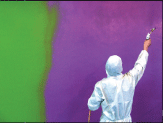 |
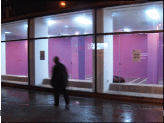 |
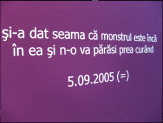 |
|
|||||||||||||||||
 |
|
|||||||||||||||||||
| |
|
|
|
|||||||||||||||||
| |
|
|
|
|
|
|
|
|
|
|
|
|
|
|
|
|
|
|
|
|